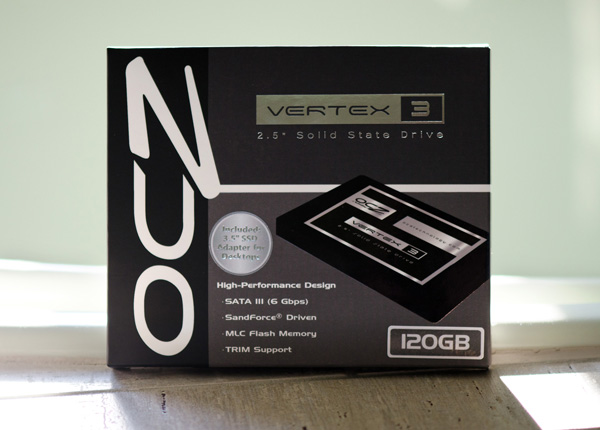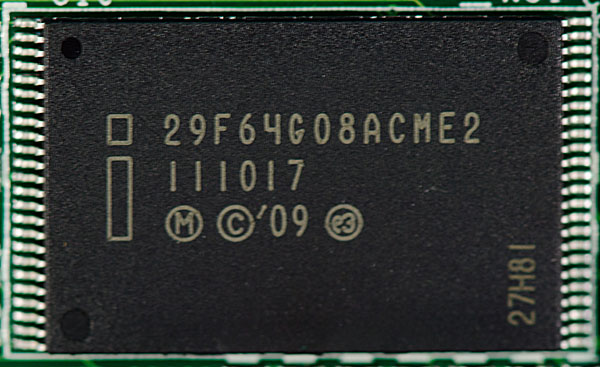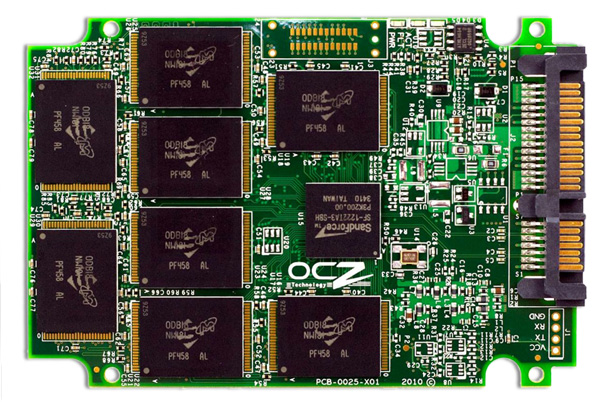The OCZ Vertex 3 Review (120GB)
by Anand Lal Shimpi on April 6, 2011 6:32 PM ESTSandForce was first to announce and preview its 2011 SSD controller technology. We first talked about the controller late last year, got a sneak peak at its performance this year at CES and then just a couple of months ago brought you a performance preview based on pre-production hardware and firmware from OCZ. Although the Vertex 3 shipment target was originally scheduled for March, thanks to a lot of testing and four new firmware revisions since I previewed the drive, the officially release got pushed back to April.
What I have in my hands is retail 120GB Vertex 3 with what OCZ is calling its final, production worthy client firmware. The Vertex 3 Pro has been pushed back a bit as the controller/firmware still have to make it through more testing and validation.
I'll get to the 120GB Vertex 3 and how its performance differs from the 240GB drive we previewed not too long ago, but first there are a few somewhat-related issues I have to get off my chest.
The Spectek Issue
Last month I wrote that OCZ had grown up after announcing the acquisition of Indilinx, a SSD controller manufacturer that was quite popular in 2009. The Indilinx deal has now officially closed and OCZ is the proud owner of the controller company for a relatively paltry $32M in OCZ stock.
The Indilinx acquisition doesn't mean much for OCZ today, however in the long run it should give OCZ at least a fighting chance at being a player in the SSD space. Keep in mind that OCZ is now fighting a battle on two fronts. Above OCZ in the chain are companies like Intel, Micron and Samsung. These are all companies with their own foundries and either produce the NAND that goes into their SSDs or the controllers as well. Below OCZ are companies like Corsair, G.Skill, Patriot and OWC. These are more of OCZ's traditional competitors, mostly acting as assembly houses or just rebadging OEM drives (Corsair is a recent exception as it has its own firmware/controller combination with the P3 series).
By acquiring Indilinx OCZ takes one more step up the ladder towards the Intel/Micron/Samsung group. Unfortunately at that level, there's a new problem: NAND supply.
NAND Flash is not unlike any other commodity. Its price is subject to variation based on a myriad of factors. If you control the fabs, then you generally have a good idea of what's coming. There's still a great deal of volatility even for a fab owner, process technologies are very difficult to roll out and there is always the risk of issues in manufacturing, but generally speaking you've got a better chance of supply and controlled costs if you're making the NAND. If you don't control the fabs, you're at their mercy. While buying Indilinx gave OCZ the ability to be independent of any controller maker if it wanted to, OCZ is still at the mercy of the NAND manufacturers.
Currently OCZ ships drives with NAND from four different companies: Intel, Micron, Spectek and Hynix. The Intel and Micron stuff is available in both 34nm and 25nm flavors, Spectek is strictly 34nm and Hynix is 32nm.
Each NAND supplier has its own list of parts with their own list of specifications. While they're generally comparable in terms of reliability and performance, there is some variance not just on the NAND side but how controllers interact with the aforementioned NAND.
Approximately 90% of what OCZ ships in the Vertex 2 and 3 is using Intel or Micron NAND. Those two tend to be the most interchangeable as they physically come from the same plant. Intel/Micron have also been on the forefront of driving new process technologies so it makes sense to ship as much of that stuff as you can given the promise of lower costs.
Last month OWC published a blog accusing OCZ of shipping inferior NAND on the Vertex 2. OWC requested a drive from OCZ and it was built using 34nm Spectek NAND. Spectek, for those of you who aren't familiar, is a subsidiary of Micron (much like Crucial is a subsidiary of Micron). IMFT manufactures the NAND, the Micron side of it takes and packages it - some of it is used or sold by Micron, some of it is "sold" to Crucial and some of it is "sold" to Spectek. Only Spectek adds its own branding to the NAND.
OWC published this photo of the NAND used in their Vertex 2 sample:
I don't know the cause of the bad blood between OWC and OCZ nor do I believe it's relevant. What I do know is the following:
The 34nm Spectek parts pictured above are rated at 3000 program/erase cycles. I've already established that 3000 cycles is more than enough for a desktop workload with a reasonably smart controller. Given the extremely low write amplification I've measured on SandForce drives, I don't believe 3000 cycles is an issue. It's also worth noting that 3000 cycles is at the lower end for what's industry standard for 25nm/34nm NAND. Micron branded parts are also rated at 3000 cycles, however I've heard that's a conservative rating.
If you order NAND from Spectek you'll know that the -AL on the part number is the highest grade that Spectek sells; it stands for "Full spec w/ tighter requirements". I don't know what Spectek's testing or validation methodology are but the NAND pictured above is the highest grade Spectek sells and it's rated at 3000 p/e cycles. This is the same quantity of information I know about Intel NAND and Micron NAND. It's quite possible that the Spectek branded stuff is somehow worse, I just don't have any information that shows me it is.
OCZ insists that there's no difference between the Spectek stuff and standard Micron 34nm NAND. Given that the NAND comes out of the same fab and carries the same p/e rating, the story is plausible. Unless OWC has done some specific testing on this NAND to show that it's unfit for use in an SSD, I'm going to call this myth busted.













153 Comments
View All Comments
erple2 - Friday, April 8, 2011 - link
I believe that the issue is scale. It would not be possible financially for OCZ to issue a massive recall to change the packaging on all existing drives in the marketplace. Particularly given that while the drives have different performance characteristics (I'd like to see what the real world differences are, not just some contrived benchmark), it's not like one drive fails while another works.So it sounds to me like they're doing more or less what's right, particularly given the financial difficulty of a widespread recall.
Dorin Nicolaescu-Musteață - Thursday, April 7, 2011 - link
IOmeter results for the three NAND types are the same for both compressible and uncompressible data in ”The NAND Matrix”. Yet, the text suggests the opposite.gentlearc - Thursday, April 7, 2011 - link
The Vertex 3 is slowerIt doesn't last as long
Performance can vary
Why would you write an entire article justifying a manufacturers decisions without speaking about how this benefits the consumer?
The real issue is price and you make no mention of it. If I'm going to buy a car that doesn't go as fast, has a lower safety rating, and the engine can be any of 4 different brands, the thing better be cheaper than what's currently on the market. If the 25nm process allows SSDs to break a price barrier, then that should be the focal point of the article. What is your focal point?
"Why not just keep using 34nm IMFT NAND? Ultimately that product won't be available. It's like asking for 90nm CPUs today, the whole point to Moore's Law is to transition to smaller manufacturing processes as quickly as possible."
Pardon? This is not a transistor count issue, it's further down the road. I am surprised you would quote Moore's Law as a reason why we should expect worse from the new generation of SSDs. The inability for a company to address the complications of a die shrink are not the fault of Moore's Law, it's the fault of the company. As you mentioned in your final words, the 250GB will probably be able to take better advantage of the die shrink. Please don't justify manufacturers trying to continue using a one-size-fits-all approach without showing how we, the consumer (your readership), are benefited.
erple2 - Friday, April 8, 2011 - link
I think that you've missed the point entirely. The reason why you can't get 34nm IMFT NAND going forwards, is that Intel is ramping that production down in favor of the smaller manufacturing process. They may already have stopped manufacturing those products in bulk. Therefore, the existing 34nm NAND is "dying off". They won't be available in the future.The point about Moore's Law - I think Anand may be stretching the meaning of Moore's Law, but ultimately the reason why we get faster, smaller chips is because of cost. It's unclear to me what the justification behind Moore's law is, but ultimately, that's not important to the actual Law itself. It is simply a reflection of the reality of the industry.
I believe transistor count IS the issue. The more transistors Intel (or whomever) can pack in to a memory module for the same cost to them (thereby increasing capacity), the more likely they are to do that. It is a business, after all. Higher density can be sold to the consumer at a higher price (more GB's = more $'s). Intel (the manufacturer of the memory) doesn't care whether the performance of the chips is lower to some end user. As you say, it's up to the controller manufacturer to figure out how to take into account the "issues" involved in higher density, smaller transistor based memory. If you read the article again, Anand isn't justifying anything - he's simply explaining the reasons behind why RIGHT NOW, 25nm chips are slower on existing SF drives than 34nm chips are.
It's more an issue of the manufacturers trying to reuse "old" technology for the current product line, until the SF controller optimizations catch up to the smaller NAND.
gentlearc - Saturday, April 9, 2011 - link
Once again, why do an article explaining a new product that is inferior to the previous generation with no reason why we should be interested? AMD's Radeon HD 6790 was titled "Coming Up Short At $150" because regardless of the new technology, it offers too little for too much. Where is the same conclusion?Yes, this article was an explanation. Anand does a 14-page explanation, saving a recommendation for the future.
"The performance impact the 120GB sees when working with incompressible data just puts it below what I would consider the next-generation performance threshold."
The questions remains. Why should the120GB Vertex 3 debut $90 more than it's better performing older brother?
mpx999 - Sunday, April 10, 2011 - link
If you have a problem with speed of flash memory then a good choice for you are drives with SLC memory, which doesn't have as much speed limitations. Unfortunately manufacturers severy overprice them, as SLC drives are much more than 2 times more expansive than MLC ones at the same amount GB, despite the fact that the flash is only 2 times more expansive. You can buy reasonably priced (2x MLC version price) SDHC cards with SLC flash, but you can't get reasonably priced (2 x MLC version price) SSD with SLC flash.taltamir - Thursday, April 7, 2011 - link
"After a dose of public retribution OCZ agreed to allow end users to swap 25nm Vertex 2s for 34nm drives"Actually OCZ lets customers swap their 25nm 64Gbit drives for 25nm 32Gbit drives. There are no swaps to the 32nm 32Gbit drives
garloff - Thursday, April 7, 2011 - link
Anand -- thanks for your excellent coverage on SSDs -- it's the best that I know of. And I certainly appreciate your work with the vendors, pushing them for higher standards -- something from which everybody benefits.One suggestion to write power consumption:
I can see drives that write faster consume more power -- that's no surprise, as they write to more chips (or the SF controller has to compress more data ...) and it's fair. They are done sooner, going back to idle.
Why don't you actually publish a Ws/GB number, i.e. write a few Gigs and then measure the energy consumed to do that? That would be very meaningful AFAICT.
(As a second step, could could also do a mix, by having a bench run for 60s, writing a fixed amount of data and then comparing energy consumption -- faster drives will be longer in idle than slower ones ... that would also be meaningful, but that's maybe a second step. Or you measure the energy consumed in your AS bench, assuming that it transfers a fixed amount of data as opposed to running for a fixed amount of time ...)
Nihil688 - Thursday, April 7, 2011 - link
Hello all,I am kinda new to all this and since I am about to get a new 6GB/s Sata3 system I need to ask this
The main two SSDs that I am considering are the Micron's C400 or the OCZ Vertex3 120' version.
I can see that their sequential speeds in both write and read are completely different with V3 winning
but their Random IOPSs (always comparing the 120GB V3 and the 128GB C400) differ with C400 winning in reads and V3 winning with big difference in writes.
I must say I am planning to install my windows 7 OS in this new SSD I am getting and what I would
consider doing is the following:
-Compiling
-Installing 1 game at a time, playing, erasing, redo
-Maybe Adobe work: Photoshop etc
So I have other hard drives to store stuff but the SSD would make my work and gaming quite faster.
The question is, C400 gives 40K of read which is more important for an OS whilst V3 gives better overall stats and is only lacking in random reads. What would be more important for me? Thanks!
PaulD55 - Thursday, April 7, 2011 - link
Connected my 120 Gig Vertex 3 ( purchased from New Egg) , booted and saw that it was not recognized by the BIOS, I then noticed the drive was flashing red and green. Contacted OCZ and was told the drive was faulty and should be returned. New Egg claims they have no idea when these will be back in stock.